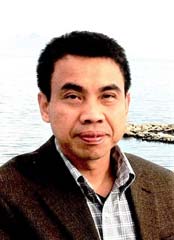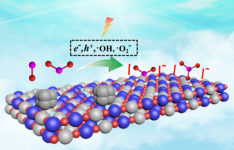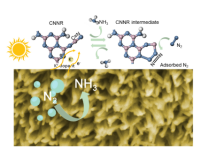
Prof. Chuanyi Wang
Shaanxi University of Science & Technology, China
Title: Defect-engineering towards Improved Photocatalytic Conversion of Nitrogen Oxide and Nitrogen Gaseous Molecules
Abstract:
No doubt, the goal of China to achieve carbon neutrality in 2060 is formidable and challenging. In the context of carbon neutrality, green and low carbon technologies are highly desired. Photocatalysis is a kind of technology, ideally, converting solar energy into chemical energy, which has been demonstrated to hold great promise in many fields [1-3]. Considering solar energy is green and sustainable, its utilization should benefit carbon neutrality. From this prospect, in this presentation, we focus on converting N-containing molecules with assistance of solar energy-based photocatalysis. Among various N-containing molecules, we take NO and N2 as representatives. Effective photocatalytic NO conversation and N2-fixation were achieved over defects-engineered Ti-based perovskites and carbon nitrides etc. (Fig.1). Comparing with traditional N-containing molecules’ conversion under harsh conditions with high temperature and pressure, the present photocatalytic conversion is much more beneficial to carbon neutrality. Furthermore, mechanistic insights into the conversion processes involving the role of defect engineering were presented. Overall, the present work highlights the vital role of defect engineering in photocatalysis towards carbon neutrality and sustainability.


Figure 1. Schematic
description of photocatalytic NO conversion and N-fixation
Acknowledgement: This work was
supported by the National Natural Science Foundation of China (No. 52161145409).
[1] L. Wang, C.Y. Wang et al. Angew. Chem. Int. Ed., 2019, 58(24), 8103-8108.
[2] Q.H. Zhu, C.Y. Wang
et al. Appl. Catal. B, 2022, 319, 121888.
[3] C.Y.
Wang et al.
Full Spectrum Responsive
Materials, Elsevier, World Publishing,
2024.
Biography:
Before moving to SUST in
2017, Dr. Wang was a distinguished professor of Chinese Academy of Sciences
(CAS), serving as Director of Laboratory of Environmental Science and Technology
of Xinjiang Technical Institute of Physics & Chemistry, and Head of CAS
International Creative Research Team as well as Innovation Cross-Team.
Dr. Wang obtained his
Ph.D. degree from CAS with honor in 1998, worked in Germany (Institute for
Solar Energy Research in Hannover and Free University Berlin) as an Alexander
von Humboldt research fellow from 1999 to 2000, and then worked in USA (Tufts
University and Missouri University-Kansas City) from 2000 to 2010.
Dr. Wang has led more than
30 national/international research projects, including prestigious key research
projects sponsored by NSFC and CAS. His research covers energy and
environmental photocatalysis, environmental materials, and surface/interface
chemistry. He has published over 400 peer-reviewed articles with over 21,000 citations
and H-index 82, authorized 65 Chinese/ US patents, edited/authored 3
monographs, and has given over 260 invited talks at national/international
conferences and research institutions.
Dr. Wang is an elected Life
Fellow of RSA, a Fellow of RSC and a Fellow of IAAM, named in Wikipedia, Who’s
Who in the World, and the list of the “World’s Top 2% Scientists” since 2021
(ranked top 100 in Physical Chemistry). He is also a recipient of several prestigious
awards, including China Tianshan Prize, Contribution Award of Overseas Chinese
in China, and Highly Cited Researcher (Clarivate), and Advanced Materials
Laureate etc.
Dr. Wang is serving
on multiple editorial and scientific advisory boards or organizations, e.g.,
Associate Editor for Environmental
Chemistry Letters IF 15.7), Distinguished Expert for HOME Program of China Association for
Science and Technology,
executive director of
China Energy Society, Chairman of series national/international conferences, proposal reviewer and final panel for MOST (China), National Science
and Technology Award final review, National Science Centre Poland, etc.